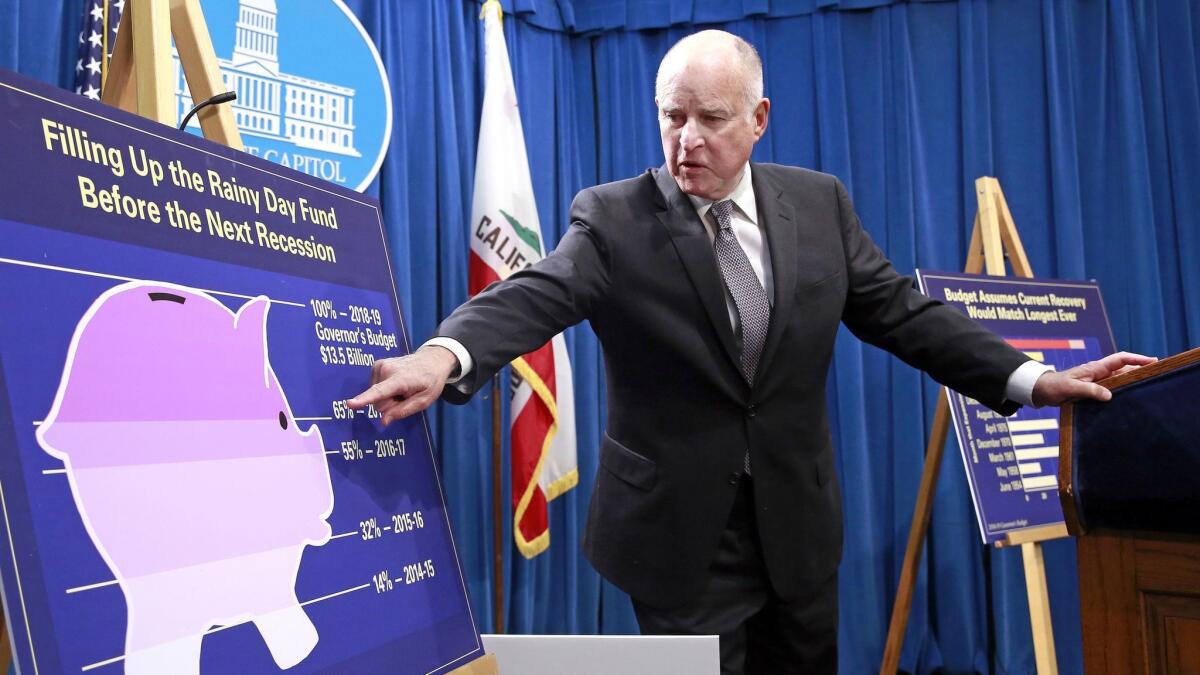Capitol Journal: California’s state budgets represent a seemingly unstoppable rise in government spending

It’s nothing to pop champagne corks about, but California state government is reaching a historic milestone: its first $200-billion spending plan.
It wasn’t very long ago that Sacramento had its first $100-billion budget. In fact, people who saw the first $10-billion budget are still around. I’m one.
Gov. Jerry Brown and legislative leaders have compromised on a budget deal that lawmakers must pass by midnight Friday or they’ll lose their pay. So it definitely will pass. Brown will sign it before the fiscal year begins July 1.
There’s also a large stack of “trailer” bills needed to implement the budget. They can be passed after the Friday deadline.
Here’s how the budget breaks down: $138.6 billion for the general fund, the government’s main checking account; $57.1 billion for special funds, largely for safety net and transportation programs; and $3.9 billion for bond debt.
That totals $199.6 billion, a tad short of the milestone number. But the total will grow virtually every day. Bet on it. When the current budget was signed last year, it was pegged at $183 billion. In only six months, it grew by more than $5 billion. That’s government.
So what’s the big deal about a $200-billion budget? It’s a lamppost that highlights the rapid, seemingly unstoppable rise in California government spending, regardless of Brown’s widely lauded fiscal prudence.
Some perspective: It took the state an entire century to reach a $1-billion budget in 1950. Adjusted for inflation, that would amount to $17 billion in today’s dollars, according to the state finance department.
California’s population has nearly quadrupled since 1950. So for argument’s sake, quadruple $17 billion to $68 billion. That’s still light-years short of $200 billion.
Much has changed since 1950 to jack up state spending. Some good, some bad.
Primarily under Gov. Pat Brown — Jerry’s dad — California went on a building binge in the late 1950s and early ’60s, helped by a generous federal government. Big projects included highways, university campuses and waterworks. That was good.
President Lyndon Johnson declared a war on poverty in the mid-’60s and persuaded Congress to create Medicaid healthcare for poor people along with Medicare for seniors. In California, Medicaid is called Medi-Cal. Welfare also became more generous. That was good, but very expensive.
The largest spending category in the state budget is health and human services, currently eating up 32% of money from all funds. K-12 schools are the largest general fund drain, taking 41%.
In 1967, Gov. Ronald Reagan signed the first $5-billion budget. In 1974, he inked the first $10-billion spending plan.
Then in 1978, voters passed Proposition 13, dramatically cutting property taxes. That jacked up state spending significantly. Sacramento took over two-thirds of school funding. Before Proposition 13, two-thirds came from property taxes; afterward just one-third. The state also kicked in more for local governments. Good for property owners, bad for state spending.
And under Gov. George Deukmejian, we started locking up more criminals for longer periods and building new prisons. Good, but costly.
“The general fund goes four places: K-12 schools, higher education, corrections, and health and welfare. Everything else is budget dust,” says Tom Hayes, who was finance director for Gov. Pete Wilson and, before that, state treasurer and auditor general.
Hayes adds: “Pensions are the elephant in the room. They’re just huge out there. That’s going to be paid for by our kids and grandkids.”
Gov. Gray Davis opened the vault for state workers’ pension plans in 1999. He was assured by state retirement officials that pension fund investments would pay for the generous benefit boosts. Wrong. Bad move.
Coverage of California politics »
Today, unfunded liabilities for state pensions are conservatively estimated at $136 billion, but they’re probably much higher. For all state and local public pensions systems, the unfunded liabilities are at least $333 billion. But they could be closer to $1 trillion.
Roughly a half-century after California’s first $1-billion state budget, Davis crashed through the $100-billion mark in 2002. The next year he was recalled, largely because of spending, taxes and an energy crisis.
Adjusted for inflation, Davis’ $107-billion budget would amount to $166 billion today, the finance department calculates.
In a rarity, state spending plummeted during the Great Recession, falling from $138 billion in 2007 to $117 billion in 2009.
Brown brags, with some justification, about inheriting a $27-billion budget deficit and turning it into a $9-billion surplus.
Two things about that:
One, Brown kept Democratic spending in check, but he also raised income taxes astronomically on the wealthy. Maybe all those taxes weren’t necessary in the rebounding economy.
Two, state spending under Brown — despite his skinflint image — has risen from roughly $131 billion to $200 billion, 53% in eight years.
Why does spending keep climbing steeply, decade after decade?
“There’s no pressure to control spending,” Hayes says. “I never got lobbied once to spend less. Everyone came in and asked to spend more. That’s nonpartisan. They just came in and said, ‘You can’t raise taxes.’”
Wilson needed to hike taxes, however, and bravely did.
“The electorate doesn’t seem to be very concerned about spending,” Hayes says.
Nothing has changed — in the Capitol or the citizenry.
When will Sacramento crank out its first $300-billion budget? At the current pace, absent another great recession, probably about the time Gavin Newsom finishes up his second term as governor.
Follow @LATimesSkelton on Twitter
More to Read
Get the L.A. Times Politics newsletter
Deeply reported insights into legislation, politics and policy from Sacramento, Washington and beyond. In your inbox three times per week.
You may occasionally receive promotional content from the Los Angeles Times.







